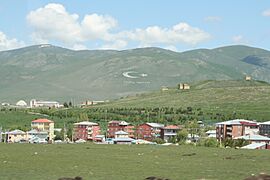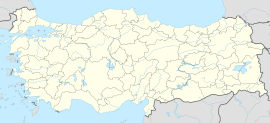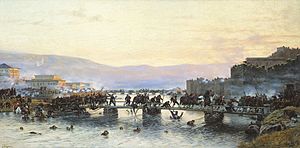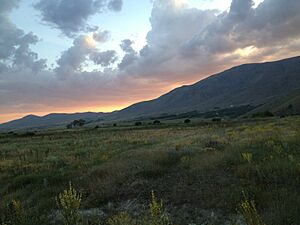Ardahan facts for kids
Quick facts for kids
Ardahan
|
|
|---|---|
 |
|
| Country | Turkey |
| Province | Ardahan |
| District | Ardahan |
| Elevation | 1,811 m (5,942 ft) |
| Population | 22,927 |
| Time zone | TRT (UTC+3) |
| Postal code |
75000
|
Ardahan (Georgian: არტაანი, romanized: art'aani; Armenian: Արդահան, romanized: Ardahan; Kurdish: Erdêxan; Russian: Ардаган) is a city in northeastern Turkey. It is located very close to the border with Georgia. Ardahan is the main city of Ardahan Province and Ardahan District. In 2021, about 22,927 people lived there.
Contents
History of Ardahan
Ancient and Medieval Times
Ardahan has a very long history. It was once part of a region called Gogarene, which was part of ancient Armenia. Later, it became an important place for trading goods. Things would come from the Abbasid Caliphate (a large Islamic empire) and then be sent to areas around the Black Sea.
From the 700s to the 900s, the area was controlled by the Bagrationi princes. These were rulers from a powerful family in a region called Tao-Klarjeti. Ardahan then became part of the Kingdom of Georgia from the 1000s to the 1400s. In 1021, historical records say that the Byzantines attacked Ardahan and many people living there were killed.
The Mongols took over Ardahan in the 1230s. But the Georgian princes of Samtskhe managed to get it back in 1266. In 1555, a peace treaty divided the region. Ardahan became part of the Ottoman Empire. The Ottomans made Ardahan a strong fortress city.
In the 1640s, a traveler named Evliya Çelebi visited Ardahan. He described the fortress as being on a very high cliff. He also noted that the climate was cold, so fruits and gardens were not common. Food had to be brought in from other places.
Modern History
Before 1829, Ardahan had about 400 families, mostly Armenian. Many of them moved to the Russian Empire in the early 1800s. Ardahan was a key road junction during the Russo-Turkish War (1828–1829). It connected the fortress of Akhaltsikhe to the main road between Kars and Erzurum.
After the Russo-Turkish War (1877–1878), Ardahan became part of Russia. It was made a part of the Kars Oblast region. At this time, many different groups of people lived in Ardahan. These included Armenians, Georgians, Pontic Greeks, Caucasus Jews, Russians, Kurds, Ossetians, and Yazidis. There was even a Polish community, often soldiers sent there by the Russian Army.
Ardahan's economy grew under Russian rule. The city exported fruits, smoked lamb meat, wheat, and wood. New roads were built, connecting Ardahan to other important towns.
During the early days of First World War, in December 1914, the Ottoman Army took over Ardahan. Many Armenians, Pontic Greeks, and Georgians living there faced difficult times. Russian forces, helped by Armenian and Pontic Greek groups, recaptured the town in January 1915. This allowed some people who had left to return.
After the October Revolution, Russian forces left the area. A small group of Armenian volunteers tried to defend Ardahan from the approaching Ottoman Army. On March 6, 1918, the Ottoman army, with help from some local Muslims, took control of Ardahan again.
Ardahan was then occupied by the Democratic Republic of Georgia in April 1919. When the Turkish Nationalists captured Ardahan in February 1921, the remaining Armenians, Pontic Greeks, and Georgians moved away. They went to Armenia, northern Greece, and Georgia. The Treaty of Moscow, signed in 1921, confirmed that Ardahan was part of Turkey.
In 1986, a short description of the Ardahan fortress was published. The old walls of Ardahan Kalesi were rebuilt many times over the years. In the 1800s, they were changed to hold small cannons. By 1960, Ardahan's population was 7,228 people, made up of both Kurds and Turks.
Population Changes
The number of people living in Ardahan has changed a lot over time. Here's a look at the population and the different groups of people who lived there in the past:
| Year | Total | Ethnic groups |
|---|---|---|
| 1886 | 778 | Turks 403 (51.8%), Russians 172 (22.1%), Armenians 141 (18.1%), Greeks 48 (6.2%), Kurds 7 (0.9%) |
| 1897 | 4,142 | Russians 1,331 (32.1%), Armenians 1,315 (31.7%), Turks 746 (18%), Poles 206 (5%) |
| 1916 | 3,167 | Armenians 1,708 (53.9%), Sunni Muslims 778 (24.6%), Roma 361 (11.4%), Russians 270 (8.5%) |
| 1960 | 7,228 | |
| 1970 | 13,399 | |
| 1980 | 14,912 | |
| 1990 | 16,761 | |
| 2000 | 17,274 | |
| 2010 | 16,251 |
Geography of Ardahan
Ardahan is located in northeastern Turkey, very close to the Georgian border. It sits on the upper part of the Kura River. This river flows south of the Yalnızçam Mountains. The city is divided into seven main areas, or quarters: Halilefendi, Karagöl, Kaptanpaşa, Yenimahalle, Gürçayir, Atatürk, and Inönü.
Ardahan's Climate
Ardahan has a type of weather called a humid continental climate. This means it has four distinct seasons. It's almost like a subarctic climate in higher areas, which means it can get very cold.
Summers in Ardahan are usually mild to warm during the day. However, nights can get quite cool. It's even possible for temperatures to drop below freezing in any month of the year. Rain is common for most of the year, especially in spring and summer.
Winters are very snowy. Snow usually covers the ground from late October until mid-April. While it can snow in September and May, heavy snow that stays on the ground is rare. Sometimes, it has even snowed in summer months, like in August 2013! The most snow ever recorded at once was 113 centimeters (about 44.5 inches) on January 30, 1968.
- The highest temperature ever recorded was 35.0 °C (95.0 °F) on August 29, 1998.
- The lowest temperature ever recorded was -39.8 °C (-39.6 °F) on January 21, 1972.
| Climate data for Ardahan (1991–2020, extremes 1958–2023) | |||||||||||||
|---|---|---|---|---|---|---|---|---|---|---|---|---|---|
| Month | Jan | Feb | Mar | Apr | May | Jun | Jul | Aug | Sep | Oct | Nov | Dec | Year |
| Record high °C (°F) | 11.1 (52.0) |
11.0 (51.8) |
18.4 (65.1) |
25.0 (77.0) |
28.9 (84.0) |
33.1 (91.6) |
34.3 (93.7) |
35.0 (95.0) |
32.1 (89.8) |
26.0 (78.8) |
18.7 (65.7) |
14.3 (57.7) |
35.0 (95.0) |
| Mean daily maximum °C (°F) | −4.4 (24.1) |
−2.7 (27.1) |
3.6 (38.5) |
11.1 (52.0) |
16.4 (61.5) |
20.8 (69.4) |
24.3 (75.7) |
25.2 (77.4) |
21.2 (70.2) |
15.2 (59.4) |
6.7 (44.1) |
−1.5 (29.3) |
11.3 (52.3) |
| Daily mean °C (°F) | −10.3 (13.5) |
−9.1 (15.6) |
−2.3 (27.9) |
4.7 (40.5) |
9.6 (49.3) |
13.3 (55.9) |
16.4 (61.5) |
16.7 (62.1) |
12.5 (54.5) |
7.2 (45.0) |
−0.1 (31.8) |
−7.3 (18.9) |
4.3 (39.7) |
| Mean daily minimum °C (°F) | −15.5 (4.1) |
−14.6 (5.7) |
−7.5 (18.5) |
−0.8 (30.6) |
3.6 (38.5) |
6.5 (43.7) |
9.4 (48.9) |
9.3 (48.7) |
4.9 (40.8) |
0.7 (33.3) |
−5.4 (22.3) |
−12.1 (10.2) |
−1.8 (28.8) |
| Record low °C (°F) | −39.8 (−39.6) |
−38.7 (−37.7) |
−33.2 (−27.8) |
−19.0 (−2.2) |
−8.5 (16.7) |
−4.5 (23.9) |
−2.2 (28.0) |
−2.8 (27.0) |
−5.8 (21.6) |
−15.0 (5.0) |
−28.9 (−20.0) |
−36.3 (−33.3) |
−39.8 (−39.6) |
| Average precipitation mm (inches) | 24.0 (0.94) |
21.7 (0.85) |
37.0 (1.46) |
54.2 (2.13) |
85.2 (3.35) |
101.7 (4.00) |
77.2 (3.04) |
64.8 (2.55) |
38.9 (1.53) |
41.1 (1.62) |
29.9 (1.18) |
24.7 (0.97) |
600.4 (23.64) |
| Average precipitation days | 9.13 | 9.4 | 11.53 | 13.87 | 16.93 | 15.3 | 12.37 | 12.13 | 8.53 | 11.3 | 8.77 | 9.93 | 139.2 |
| Average snowy days | 7.5 | 5.9 | 8.4 | 2.5 | 0.3 | 0 | 0 | 0 | 0 | 0.9 | 3.4 | 6.4 | 35.3 |
| Average relative humidity (%) | 75.4 | 75.1 | 72.6 | 67.6 | 68.2 | 68.6 | 68.1 | 65.7 | 65.2 | 68.8 | 72.9 | 77.3 | 70.5 |
| Mean monthly sunshine hours | 80.6 | 104.5 | 155.0 | 153.0 | 195.3 | 234.0 | 257.3 | 251.1 | 213.0 | 164.3 | 111.0 | 77.5 | 1,996.6 |
| Mean daily sunshine hours | 2.6 | 3.7 | 5.0 | 5.1 | 6.3 | 7.8 | 8.3 | 8.1 | 7.1 | 5.3 | 3.7 | 2.5 | 5.5 |
| Source 1: Turkish State Meteorological Service | |||||||||||||
| Source 2: NOAA (humidity 1991-2020), Meteomanz(snow days 2014-2023) | |||||||||||||
International Connections
Ardahan has "twin town" or "sister city" relationships with other cities around the world. This means they share cultural ties and friendly connections.
Notable People from Ardahan
- To learn about famous people who come from Ardahan, you can visit the Category:People from Ardahan page.
See also
 In Spanish: Ardahan para niños
In Spanish: Ardahan para niños




